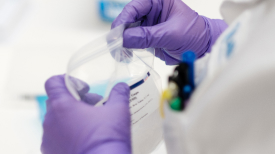- Cancer Care Team
Cancer Care Team
To deliver optimal patient outcomesProducts and Services
Cancer Type
Supplies & Tools
Scientific Focus
- Biopharma Partners
- Patients
- Education & Events
- Login
- Contact Us
Test Details
 Cancer Type
Cancer Type
Colorectal cancer (CRC), Gastric, Hairy cell leukemia (HCL), Hematologic malignancies, Lung, Melanoma, Ovarian, Thyroid
 Technology Used
Technology Used
Molecular
 Turnaround Time
Turnaround Time
5 - 7 days
Use
BRAF is an important member of the mitogen-activated protein kinase (MAPK) pathway that influences cell proliferation. This test will detect all V600 mutations of the BRAF oncogene frequently found in human cancers, such as melanoma, colorectal cancer, gastric cancer, lung cancer, ovarian cancer, thyroid cancer, and hairy cell leukemia, allowing the determination of drug response, aiding the diagnosis and providing prognosis information. More than 90% of mutations are the V600E (c1799T>A) mutation, but other V600 mutations have been reported.
This test can distinquish the following BRAF V600 mutations: V600E, V600E2, V600K, V600D, V600R, V600A, V600G, V600M, V600L.
Special Instructions
Please provide a copy of the pathology report. Direct any questions regarding this test to customer service at 800-345-4363. BRAF testing will be delayed if the pathology report is not received.
Limitations
This assay is able to detect 5% mutation in a background of wild-type DNA.
This test was developed and its performance characteristics determined by Labcorp. It has not been cleared or approved by the Food and Drug Administration.
Methodology
SNaPshot Multiplex PCR (primer extension-based method)
Specimen Requirements
Information on collection, storage, and volume
Specimen
Solid tumor: Formalin-fixed, paraffin-embedded (FFPE) tissue blocks or slides; thyroid fine needle aspirate (FNA). Leukemia: whole blood or bone marrow
Volume
FFPE tissue block or four unstained slides and one matching H&E-stained slide at 5 μM; 5 to 10 mL FNA in CytoLyt container; 3 to 5 mL whole blood, 1 to 2 mL bone marrow
Minimum Volume
Two unstained slides and one matching H&E-stained slide at 5 μM. Sample with >4mm2 and greater than or equal to 50% tumor content are preferred; 5 mL FNA; 3 mL blood, 1 mL bone marrow
Container
FFPE tissue block or slides, lavender-top (EDTA) tube, green-top (sodium heparin) tube, yellow-top (ACD-A) tube, FNA CytoLyt container, tan-top (K2-EDTA) tube or pink-top (K2-EDTA) tube
Storage Instructions
Maintain specimen at room temperature. If specimen is to be stored prior to shipment, store at 2°C to 8°C. Store FFPE block or slides, FNA in CytoLyt container at room temperature.
Causes for Rejection
Tumor block containing no tumor; broken or stained slides; specimen does not meet collection criteria; frozen whole blood, marrow, or cell pellet; leaking tube; clotted blood or marrow; grossly hemolyzed specimen or otherwise visibly degraded; contamination by another specimen; specimens containing suspicious foreign material
Related Tests
Find more tests related to this one.





